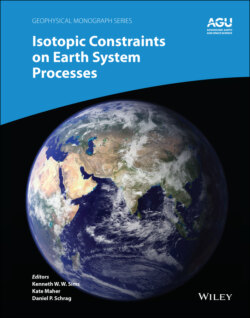Читать книгу Isotopic Constraints on Earth System Processes - Группа авторов - Страница 53
2.3.2. Ca and K Isotopes
ОглавлениеThe phonolite‐rhyolite diffusion couples produced large diffusive isotope effects in both Ca (Fig. 2.4a) and K (Fig. 2.4b). For Ca isotopes, the felsic side is enriched in the heavy isotope whereas the mafic side is enriched in the light isotope, consistent with a net flux of CaO from the felsic to the mafic liquid despite a negligible initial compositional contrast. In the 2.5‐hour run, the δ 44Ca is equal to the initial value (within error) on the felsic side. It is unclear if the δ 44Ca has changed from the initial value on the mafic side because the endmost wafer was not successfully extracted during sample preparation. The total range in δ 44Ca is about 2 in the 2.5‐hour run. In the 6‐hour run, the shape of the profile is similar but more time‐evolved. The Ca isotopic composition has changed significantly from the initial value at both ends of the capsule with a total range in δ 44Ca of about 1.5‰.
Figure 2.3 Major‐element diffusion profiles from two experiments lasting 2.5 hours and 6 hours. Note that the data have been shifted to the right by 1 mm and 2.3 mm for the 2.5 hour and 6 hour runs, respectively, in order to align the interfaces and frame the profiles within each panel. The dashed line shows the initial composition based on Table 2.1.
Figure 2.4 Isotopic profiles from two experiments lasting 2.5 hours and 6 hours. Note that the data have been shifted to the right by 1 mm and 2.3 mm for the 2.5 hour and 6 hour runs, respectively, in order to align the interfaces and frame the profiles within each panel.
For K isotopes, the shape of the profile resembles those of previous studies where the component of interest diffuses down a monotonic concentration gradient. The net K2O flux is from phonolite to rhyolite, which is opposite the CaO flux, rendering the phonolite isotopically heavy and the rhyolite isotopically light. Both ends of the diffusion couple have changed from the initial value because of the fast diffusion of the K2O component reaching both ends of the capsule. The total range in δ 41K is about 6‰.
